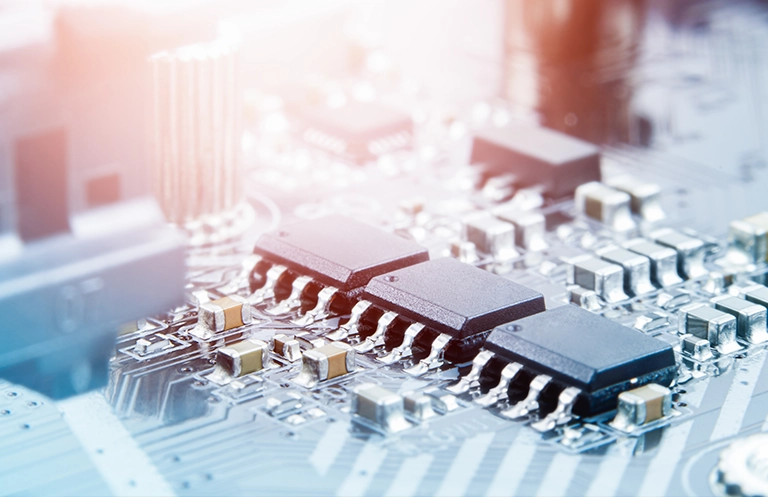Artificial Intelligence (AI) has transformed the way we interact with devices and process information. At the heart of this revolution lies a critical component: AI-enabled chips.
The need for computers to have more processing power, speed, and efficiency has increased and AI chips are crucial for satisfying this demand. By 2025, it is anticipated that these “AI chips” will account for up to 20% of the global semiconductor chip market.
These chips power many smart/IoT gadgets including smart home assistants, facial recognition cameras, voice assistants, etc. The demand for AI chips is likely to increase if the industry keeps pushing the boundaries of technology in areas like robotics, driverless cars, and generative AI. But what sets AI-enabled chipsets apart from their general –purpose counterparts? In this blog we will explore how AI’s unique architecture and capabilities are unlocking new frontiers in computing.
The Basics of AI-enabled chips
Artificial Intelligence (AI) chips comprise graphics processing units (GPUs), field-programmable gate arrays (FPGAs), and Application-specific integrated circuits (ASICs). While some basic AI activities can also be completed by general-purpose circuits like Central Processing Units (CPUs), but CPUs are becoming less and less relevant as AI develops.
The majority of the work that AI chips do is logic-related, they can handle the high data processing requirements of AI workloads, which are beyond the scope of general-purpose chips like CPUs. They frequently use a lot of faster, smaller, and more effective transistors to do this. Compared to chips with larger and fewer transistors, this architecture enables them to execute more computations per unit of energy, leading to quicker processing speeds and lower energy usage.
Additionally, AI chips have special powers that significantly speed up the calculations needed by artificial intelligence (AI) algorithms. This includes parallel processing, which enables them to carry out several calculations concurrently.
Artificial intelligence relies heavily on parallel processing because it makes it possible to carry out numerous tasks at once, performing complicated computations more quickly and effectively. AI chips are very useful for training AI models and handling AI workloads due to their unique design.
3DIC technology also plays an important character in improving AI chip performance by vertically stacking integrated circuits, resulting in increased computational density and efficiency. This advanced integration increases the overall processing speed of difficult AI operations.
How are AI-enabled chips better than general-purpose chips?
Because of their unique design features, artificial intelligence (AI) chips are far superior to conventional chips in development and implementation. Here are some of the major points that differentiate between the two of them-
- AI Chips Are Capable of Parallel Processing: The way AI chips compute differs from more general chips (like CPUs) and it is the most noticeable distinction. Artificial intelligence chips use parallel processing to do multiple calculations simultaneously, whereas general-purpose chips use sequential processing to complete one computation at a time. Large, complicated problems can be broken down into smaller ones using this method, which allows for simultaneous solutions with faster, more effective processing.
- Large capacity memory: The projected bandwidth allocation for specialized AI hardware is four to five times higher than that of general chips. This is required because, due to the necessity for parallel processing, AI applications require much greater bandwidth between processors to work efficiently.
- AI Chips Use Less Power: Compared to general-purpose chips, AI chips are intended to be more energy-efficient. Certain artificial intelligence chips utilize methods such as low-precision arithmetic, which allows them to execute calculations using fewer transistors and hence less energy. Additionally, AI chips can spread workloads more effectively than traditional chips due to their proficiency with parallel computing, which reduces energy usage.
- AI Chips Provide More Precise Outcomes: Artificial intelligence (AI) chips are typically more accurate than regular chips at tasks linked to AI, such as image recognition and Natural Language Processing (NLP) because they are specifically made for AI. Their goal is to precisely carry out the complex computations required by AI systems, minimizing the possibility of mistakes. Because quick precision is crucial in high-stakes AI applications like medical imaging and driverless cars, AI chips are an obvious choice.
- AI Chips Adapt To the Needs: Some AI chips, like FPGAs and ASICs, can be tailored to match the needs of particular AI models or applications, which enables the hardware to adapt to various tasks.
A few examples of customizations are adjusting key settings and tailoring the chip’s design to particular AI workloads. The ability to customize hardware to meet specific requirements, including differences in algorithms, data kinds, and computational demands, is crucial for the development of artificial intelligence.
eInfochips has worked on AI-driven lower geometry Multiple ASICs, with applications in search engines, data analytics, genomics, etc. To achieve this eInfochips developed automation and Python frameworks, and generated block pins. You can read more about it here.
Sneak Peek into Different Types of AI Chips
Many different types of microchips can be designed with AI characteristics, although some chip types are more suited for specific AI applications than others. Below are the types of AI chips-
Central Processing Unit (CPUs): Usually designed to carry out sequential tasks, these are general-purpose chips. A CPU’s processing power tends to decline quickly in comparison to more specialized chips, although it can handle simpler AI workloads.
Graphics Processing Units (GPUs)
These are similar to general-purpose chips, but their main purpose is parallel processing. Originally intended to handle numerous sophisticated graphics calculations simultaneously for video game images, GPUs were built with this capability in mind. With its emphasis on parallel processing, GPUs have become a popular choice for AI algorithm training, seamlessly bridging the gap between graphics and AI computations.
Field-Programmable Gate Arrays (FPGAs): On programmable logic blocks, these chips are built. To carry out intricate tasks, these blocks can link in many ways. They have parallel processing capabilities, just as GPUs. They are not, however, general purpose like CPUs and GPUs are. Though they can be reprogrammed as needed, FPGAs are often designed for specific functions.
Application-Specific Integrated Circuits (ASICs): ASICs are accelerator chips made specifically with artificial intelligence in mind. They are made specifically to support certain applications. Though they cannot be reprogrammed, ASICs have computing power comparable to that of FPGAs. They frequently perform better than general-purpose processors or even other AI chips since their circuitry has been tailored for a single task.
Neural Processing Units (NPUs): Similar to GPUs, NPUs are contemporary add-ons that let CPUs tackle AI workloads, the main difference is that they aim to build neural networks and deep learning models. NPUs are therefore excellent at handling enormous amounts of data to carry out a variety of complex AI tasks like object detection, speech recognition, and video editing.
eInfochips tackled a challenge regarding silicon verification, and low-power verification with the required expertise in RISC-V architecture, by taking ownership of functional verification and low-power verification of different interfaces of the SoC. With the help of eInfochips’s in-house reusable verification components, the verification time was reduced with the desired coverage.
To know more about our service offerings related to ASIC/FPGA, SoC design and development, and for AI/ML contact our team of experts today.
Let’s look into AI chip use cases
Without these specific AI chips, modern artificial intelligence would simply not be conceivable. Listed below are just a few use cases for them.
Autonomous Vehicles: AI chips improve the overall intelligence and safety of autonomous vehicles by expanding their capabilities. Large volumes of data gathered by a car’s cameras, LiDAR, and other sensors can be processed and interpreted by them, enabling complex tasks like picture recognition. Additionally, because of their parallel processing power, cars can make decisions in real time, enabling them to recognize impediments, navigate complex settings on their own, and adapt to changing traffic conditions.
Robotics: AI chips help with a variety of machine learning and computer vision functions, making it possible for robots to see and react to their surroundings more skillfully. This has applications in every field of robotics, from cobots cultivating fields to humanoid robots offering companionship.
Edge AI: Edge AI refers to the process by which AI chips enable AI processing on almost any smart device, including watches, cameras, and kitchen appliances. This results in lower latency, enhanced security, and increased energy efficiency since processing can happen closer to the source of the data rather than on the cloud. From smart houses to smart cities, artificial intelligence chips can be employed in everything.
Deep Neural Networks (DNN) and AI Acceleration: Deep Neural Networks (DNNs) and other machine learning models use AI chips as a sort of accelerator. By streamlining processes and offering more capacity for bigger datasets, they enhance performance. These accelerators can be installed on edge devices, data centers, or mobile phones to improve the efficiency of AI applications across several industries. ASICs, FPGAs, and GPUs have all been specifically designed to meet the unique requirements of these many kinds of AI processes.
Bottomline
AI chip development has advanced significantly from GPUs for gaming to specialized parts like NPUs, ASICs, and FPGAs. When it comes to processing intricate Artificial Intelligence algorithms, these cutting-edge pieces of technology offer better performance and energy efficiency. AI chips can be used for many useful purposes, including enhancing data center capabilities, enabling AI processing in edge devices, and improving mobile phone functionality. These customized processors are essential for maximizing artificial intelligence’s (AI) potential.
Know More : Artificial Intelligence And Machine Learning Solutions













